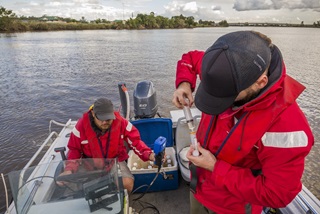 Water quality is usually defined by the physical, chemical, biological and aesthetic (appearance and smell) characteristics of water. Good water quality is essential to the health of our aquatic habitats.
Water quality is usually defined by the physical, chemical, biological and aesthetic (appearance and smell) characteristics of water. Good water quality is essential to the health of our aquatic habitats.
Monitoring water quality tells us whether actions taken to improve water quality have worked. Measuring the effectiveness of previous management enables us to better focus subsequent management.
Monitoring programs can be long- or short-term, and broadscale or local.
Waterway health report cards
We monitor and report on the health of estuaries across New South Wales to help manage and protect these complex ecosystems.
Our scientists:
- conduct research on estuaries
- collect and analyse data on estuaries
- work with local councils to conduct waterway health assessments and help them roll out monitoring programs.
Waterway health is assessed against the Australian and New Zealand Guidelines for Fresh and Marine Water Quality (formerly ANZECC 2000) and Australian River Assessment System (AusRivAS) scores and this information is presented as report cards to the community.
We’ve developed a waterway health report card system that councils can use to present monitoring information they collect,to their local community. It is an easy to understand visual report card system that everyone can use to find out about waterway health, what has been monitored and how waterway health has been maintained and improved.
For example, the Midcoast Council Waterways Report Card 2022. This water quality information can then be used to develop management programs and action plans to ensure water quality is protected.
Our goal is to expand this report card system and establish a state-wide water quality monitoring program through local councils and state agencies.
Waterway health assessment
To assess the health of our waterways we measure indicators or contaminants and characteristics. For example, colour, toxic compounds, micro-organisms, salinity, suspended sediments, and microplastics.
The range of indicators that could be measured to determine water quality is broad and can change.
The cost of a monitoring program to assess all indicators would be prohibitive, so resources are usually directed towards measuring contaminants important for the local environment or for a specific use of the water.
Most water quality testing we do is conducted by our scientists, who collect water samples and analyse them in the laboratory for a range of indicators including nutrients, chlorophyll a, turbidity and macroinvertebrates or bugs.

